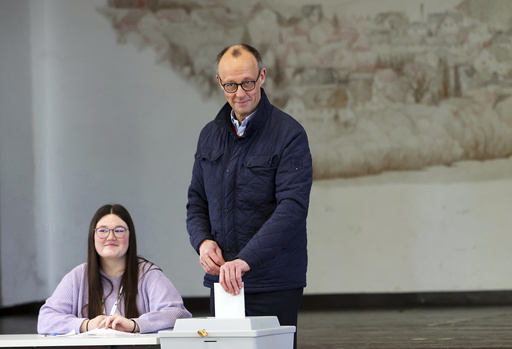German voters took to the polls on Sunday, marking a significant point in the nation’s political landscape. Opposition leader Friedrich Merz declared victory as early exit polls suggested that his party, the center-right Union bloc, was positioned at the forefront. The far-right group, Alternative for Germany (AfD), also appeared set to achieve historic heights, signaling its strongest performance for a far-right faction since World War II.
The election unfolded against a backdrop of pressing issues, including the implications of the new Trump administration in the U.S., the ongoing Russia-Ukraine conflict, and broader security concerns in Europe.
In his remarks following the exit polls, Merz acknowledged the significant challenges that lie ahead, stating that forming a new government would be no simple task. He emphasized his goal of assembling a governing coalition rapidly to address the nation’s pressing issues.
According to the exit polls from ARD and ZDF, Merz’s conservatives are in the lead, while predictions show AfD making substantial gains. Meanwhile, Chancellor Olaf Scholz’s center-left Social Democrats are projected to suffer their weakest performance in postwar history, likely securing a third-place finish. The overarching themes of the election were dominated by anxiety regarding the prolonged stagnation of Germany’s economy, the demand for stricter migration controls, and rising uncertainties surrounding Ukraine and Europe’s standing with the United States.
Polls throughout Germany were set to close at 6 p.m. local time, with immediate release of the exit polls expected thereafter. Major candidates for chancellorship were also anticipated to address their party supporters across the nation after the polls closed.
In Berlin, voters were seen casting their ballots in various conventional polling venues including schools and community centers, along with some unconventional spots like restaurants, bars, and even car dealerships. Approximately 2.43 million individuals in the capital were eligible to vote for this pivotal election.
Election officials in Munich were gearing up for the count of postal ballots, with the process beginning at 3 p.m. local time, progressing to the tallying that would commence at 6 p.m. once all polling stations had shut. Early turnout statistics indicated that around 52% of registered voters had participated four hours before the polls closed, a hopeful sign compared to a turnout of 36.5% at the same time during the 2021 election. The final participation rate from last elections was notably high at 76.4%.
The previous coalition led by Scholz, comprised of the Social Democrats, Greens, and Free Democrats, is often referred to as the “traffic light” coalition due to the party colors represented. The current election features different parties, including the Union bloc (black), Social Democrats (red), Greens (green), Free Democrats (yellow), and AfD (blue). Potential coalitions that might emerge include a “Kenya” coalition comprising the Union bloc, Social Democrats, and the Greens, or a “Germany” coalition involving the Union bloc, Social Democrats, and Free Democrats.
Over half a million newly naturalized Germans were eligible to vote this election, a significant portion of whom are originally from Syria. Many of these individuals fled their homeland over the last decade due to war and instability, adding an important relevance to their first-time participation in the electoral process, particularly as they seek stability in Germany amidst ongoing challenges in their home country.
The coalition formation process does not have a designated timeline, and Merz has expressed hope to establish a government by mid-April if his party wins. Until then, Scholz’s outgoing administration will function in a caretaker capacity until a new chancellor has been elected by the Bundestag.
In response to the rise of the AfD, mainstream German political entities have reiterated their commitment to avoiding cooperation with any far-right groups perceived as threats to democracy. This “firewall” approach includes distancing from AfD during the election.
The AfD, known for its stance against migration, has been effective in rallying support by addressing public discontent with various policies, including Germany’s green transition and responses to the COVID-19 pandemic. Additionally, Uli Hoeness, a prominent figure in Bayern Munich, has voiced his views against the rise of far-right sentiments within sports, presenting a stance that challenges players who align with such views.
As Germany anticipates the outcome of this election, the new governing body will play a crucial role in shaping responses to U.S. foreign policy under a Trump administration and addressing ongoing European security concerns.
After an electoral campaign filled with tension and public demonstrations against the rise of the AfD, the electorate cast their votes. Scholz happened to cast his ballot in Potsdam, carrying the weight of his party’s collapse last November. Voters aged 18 and above were permitted to participate, with approximately 59.2 million eligible voters across the nation.
As the elections commenced, the candidates seeking leadership included incumbent Chancellor Scholz, opposition leader Merz, Vice Chancellor and Green Party candidate Robert Habeck, and AfD co-leader Alice Weidel. This election not only carries significant implications for Germany but is also poised to influence the broader European political landscape.




